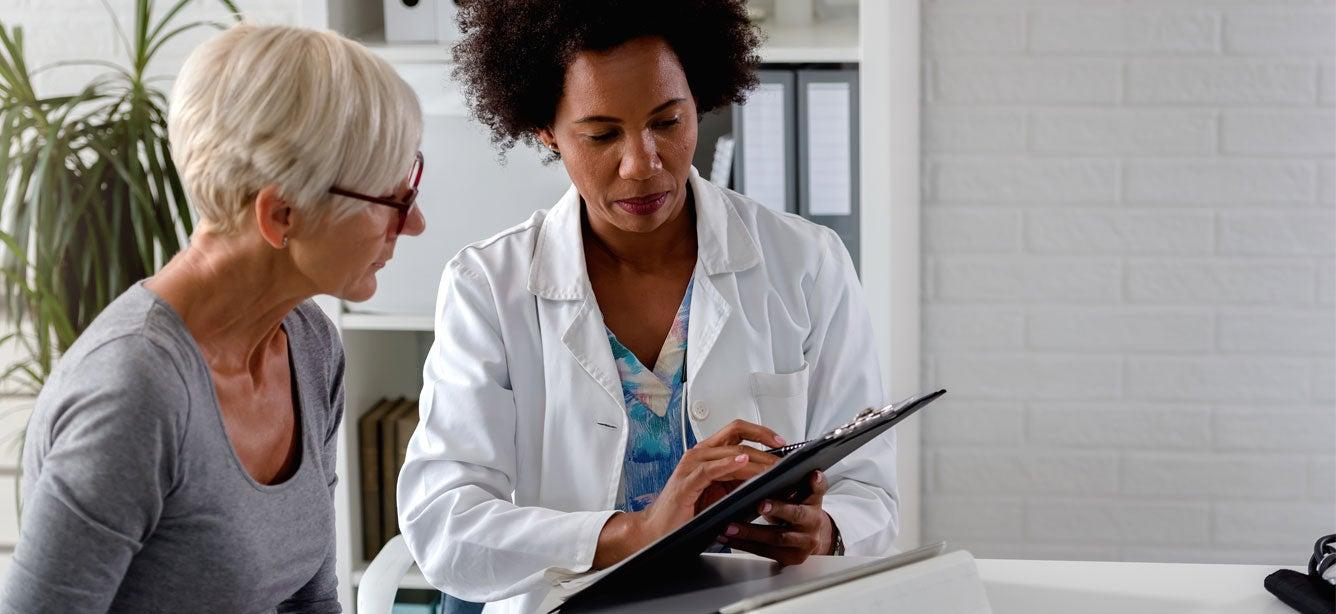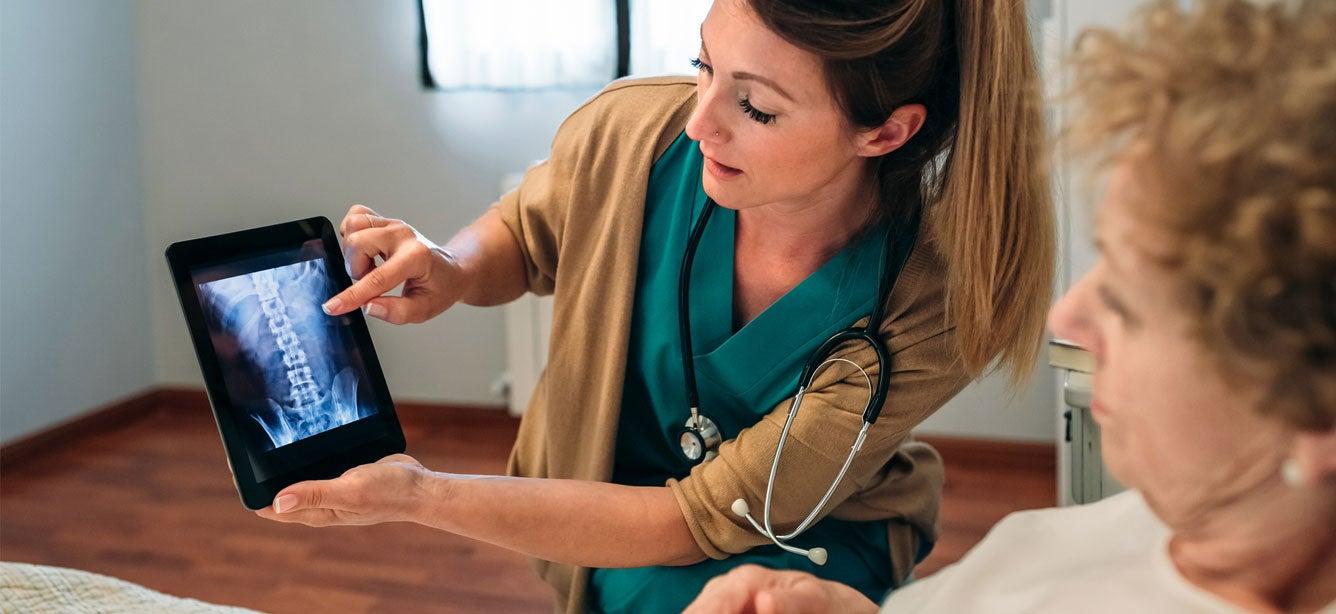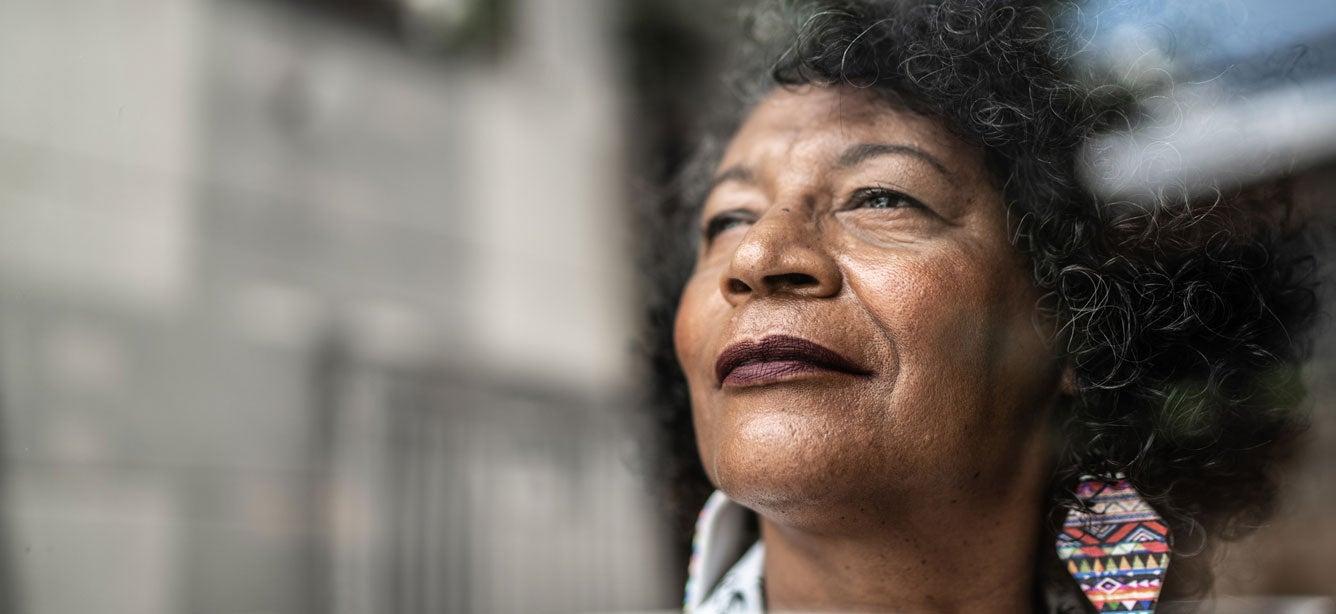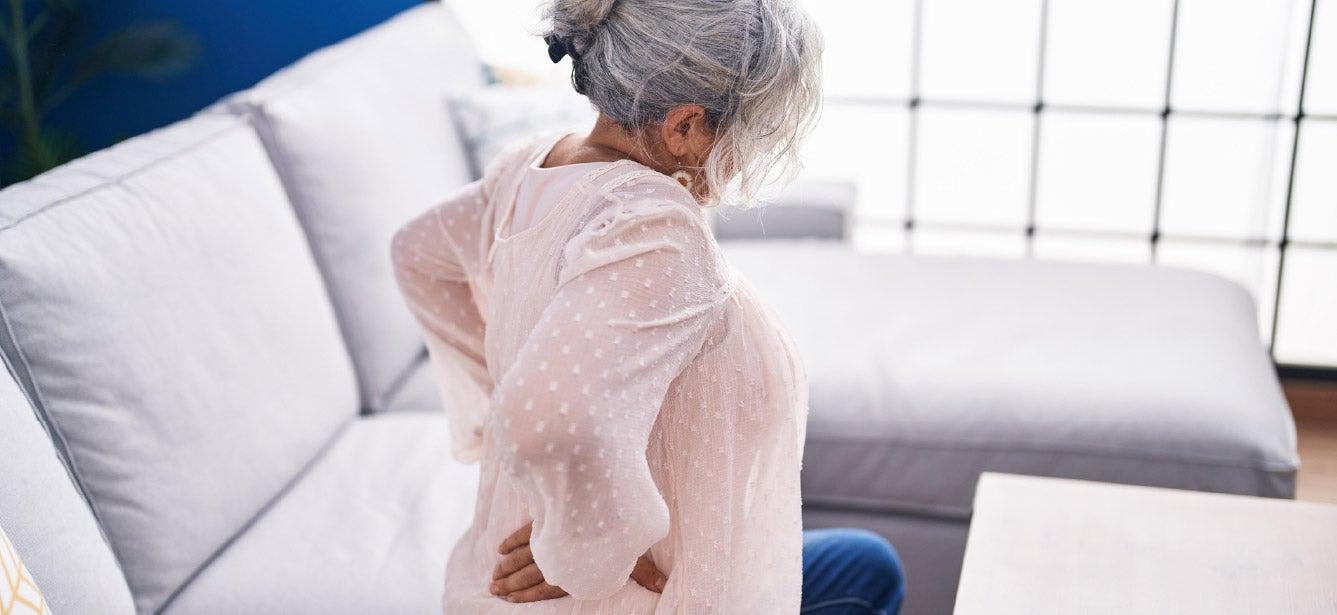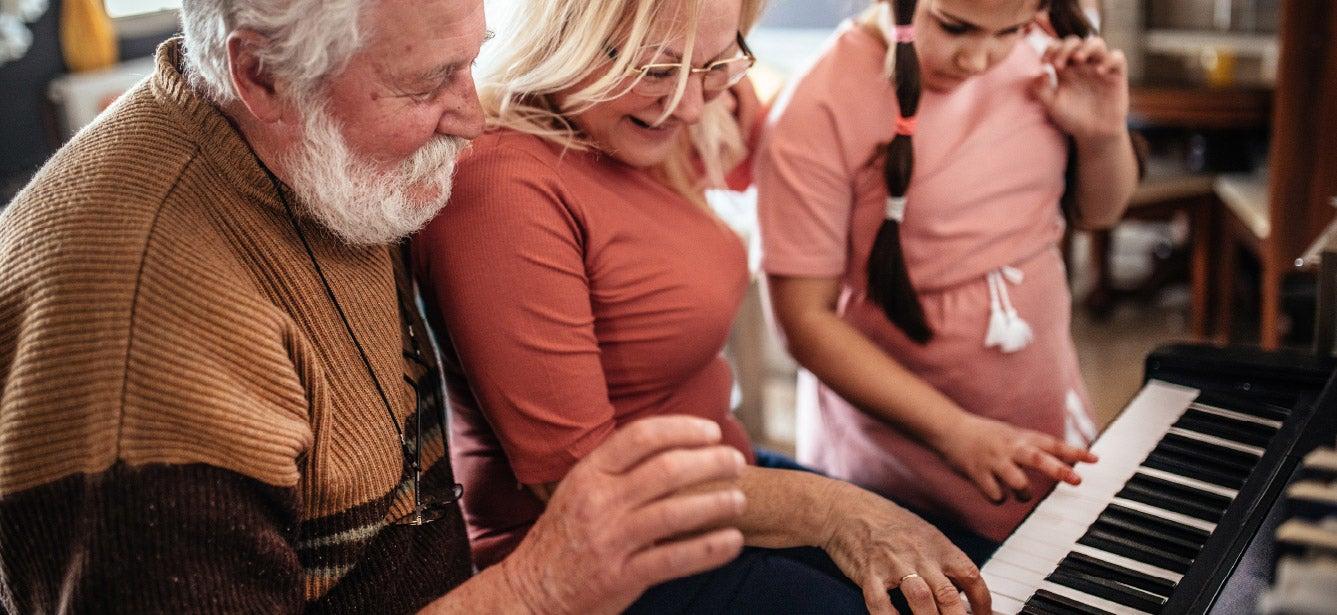
Related Topics
When 58-year-old Dr. Rebecca Sorley fell during a nature walk with her family, the music professor and performance pianist was relieved that her fingers and wrists seemed ok. As a mom, wife, and caregiver, she was used to putting on a brave face and saying everything’s fine. But then the bruising around her elbows appeared, and something did not feel right. After consulting with doctors, Rebecca got the shock of her life: both of her elbows were broken.
"So, then I thought, ‘I wonder what's wrong? Why would I land on my hands, and how would I hurt my elbows?’" she recalled. "That seemed very strange." She and her doctor decided to do a bone density test, also known as a dual energy X-ray absorptiometry (DXA) scan. The result of her test, referred to as the T-score, revealed her bone density was low, and she was diagnosed with osteoporosis. At this point, her provider prescribed a medication designed to slow bone loss and stimulate bone formation.
Rebecca is far from alone. Roughly 54 million people in the U.S. have osteoporosis, which happens when too much bone loss occurs, the body makes too little new bone, or both. As a result, bones become weak, brittle, and more prone to breakage from falls or even minor bumps.
Osteoporosis is called a “silent disease” for a reason: most people don’t know they have it until they break a bone. This held true for Rebecca, whose diagnosis caught her entirely by surprise. She was young, active, and led a healthy lifestyle. Weak bones weren’t on her radar, nor was a bone density test—since the usual recommended age for a DXA scan is 65 for women.
If I had not had that injury, they would not have given me that test because I had just turned 58,” Rebecca explained.
After learning of her osteoporosis, Rebecca developed a fear of falling. But in time, she became more convinced that awareness of the disease and working with her doctor could help her regain confidence and return to the vocation she loved. Rebecca’s story is a powerful reminder to learn your risk factors for osteoporosis—and ways you can protect your bones—before a fracture occurs. Here are some things she wants you to know.
What are the risk factors for bone loss and osteoporosis?
Some risk factors for osteoporosis are beyond our control. These include:
- Age: Research shows approximately 1 in 2 women and 1 in 4 men age 50 and older will suffer an osteoporosis-related fracture.1
- Being female: While osteoporosis affects both men and women, women are four times as likely to develop the disease than men. Women experience rapid loss of bone density due to dropping levels of estrogen around the time of menopause.
- Race/ethnicity: Osteoporosis is most common in white individuals. A 2021 report on Medicare fee-for-service (FFS) beneficiaries found that fractures due to osteoporosis occur at a higher-than-average rate in North American Natives, while occurring less among Black, Asian, and Hispanic beneficiaries. However, Black women are more likely to experience serious health and economic consequences following a fracture.2
- Family history: Whether it's your mother, father, sister, or aunt, having a close family member with osteoporosis or a history of broken bones can put you at greater risk for experiencing the same.
- Low body weight: Since they have less bone to lose, people who are thin and/or smaller in stature are more likely to develop osteoporosis. In hindsight, that may have been a contributing factor for Rebecca. “I’m of a somewhat slight build,” she said. “Typically, I guess that's one of the [risk factors].”
- Previous fractures: According to BHOF, if you are age 50 or older and have had a fracture of the hip, pelvis, spine, wrist, shoulder, or rib, you are likely to have osteoporosis. Loss of height is an osteoporosis risk factor as well. If you notice a loss of more than 1 inch in a year, it could be a sign of spine fractures.
Other osteoporosis risk factors include:
- Medical conditions: Thyroid disorders, celiac disease, and even previous weight loss surgery can raise your risk for developing osteoporosis.
- Medications: In some cases, certain medications can damage your bones and make osteoporosis more likely. These include steroids, hormone treatments, and chemotherapeutic drugs.
- Poor dietary and lifestyle habits: A diet that’s too low in calcium and vitamin D—and too high in sodium, protein, and caffeine—can increase your osteoporosis risk. This is also true for smoking, drinking alcohol in excess, and being sedentary.
What are the best ways to strengthen your bones and prevent fractures?
"Osteoporosis and broken bones are not an inevitable part of aging. However, if you break a bone after the age of 50 following a minor fall or injury, you should get a bone density test," said Dorothea Vafiadis, Director of NCOA’s Center for Healthy Aging. “It's never too late to identify and treat bone loss and take steps to avoid fractures.”
Beyond limiting alcohol use and avoiding smoking cigarettes, here are some ways older adults can lead a bone-healthy life:
Be sure to get the right amounts of calcium and Vitamin D
BHOF says women age 50 and older and men age 70 and older need about 1,200 mg of calcium per day. This can be achieved by eating three to four daily servings of calcium-rich foods, such as low-fat dairy, salmon, calcium- fortified orange juice, broccoli, kale, and sardines. Vitamin D is important also; you need 800-2,000 IU/day depending on your general health and how much time you spend in the sun. Your provider can advise you on the amounts of supplements you should take.
Rebecca’s health care provider advised her to start taking calcium and vitamin D supplements. She explained: “My doctor told me that [I] wasn’t getting enough in my diet to cover the amount I’m supposed to take in every day.”
Exercise regularly
Exercise can help you improve your strength and balance as well as your posture. Try to work in at least 30 minutes of daily physical activity that involves weight-bearing activities (for example: walking, jogging, dancing, and weightlifting). For Rebecca, walking and yoga are her “go-to” activities. She also loves swimming, which builds strength in her shoulders, neck, and arms—all important areas for piano playing. While swimming isn’t a weight-bearing exercise, water aerobics is a good option for those seeking a low-impact activity.
“Many people hear the phrase ‘weight-bearing exercise’ and think they should do heavy weightlifting. But all you need is to bear your own body weight as you move around,” Vafiadis explained. “That said, light weights could make a real difference for you.” Visit the BHOF website for more bone-friendly exercise ideas.
Prevent falls—both in and out of the home
Roughly 1 in 5 falls among older adults leads to broken bones and other serious injuries. That means preventing falls can go a long way in preventing fractures. Some basic falls prevention strategies include:
- Performing a safety review of your home and making improvements where necessary (such as installing grab bars and using non-skid area rugs).
- Doing exercises to strengthen your legs and improve your balance.
- Having your vision checked yearly and keeping your eyeglasses prescription up to date (if you wear them).
- Telling your health care provider if you're feeling dizzy or unsteady on your feet. They may want to review the medications you're taking to see if they're causing side effects that increase your risk of falls.
- Check out NCOA's Falls Prevention for Older Adults resource library for more tips on staying safe and injury-free.
Learn about your risk for fractures
The Fracture Risk Calculator from American Bone Health is for post-menopausal women and men age 45 and older who are not being treated for osteoporosis. It can help you understand your likelihood of sustaining a bone fracture in the next ten years. All it takes is answering a few simple questions.
Keep an open dialogue with your doctor
If you’re a woman who is at least 65 (70 for a man), and you haven’t had a bone density test in the last two years, ask your doctor to schedule one. Talk to them about your risk factors and be sure to share the findings from your Fracture Risk Calculator report. Together, you can evaluate your risks and develop a plan to preserve and protect your bone health. If you do have low bone density or osteoporosis, there are safe and effective medications to slow bone loss and even help your body build new bone.
As for Rebecca, she’ll have a follow-up bone density test to check on the health of her bones. “Because I’m taking supplements, and because I am on medication… I feel more confident that it's working,” she said. She’s also setting a healthy example for her 32-year-old daughter: “I think she's probably been more conscientious about the supplements that she takes because of me.”
While she’s being a bit more careful these days, Rebecca doesn’t let osteoporosis stop her—especially when it comes to her passion of playing and teaching piano.
I am able to do those things that I want to do… I feel like I appreciate it more because I couldn’t do it for a while,” Rebecca said.
Do you have a bone health or osteoporosis story like Rebecca’s to share? Tell us about it by sending an email to bonehealth@ncoa.org.
Sources
1. Cleveland Clinic. Osteoporosis. Found on the internet at https://my.clevelandclinic.org/health/diseases/4443-osteoporosis
2. Milliman. Medicare cost of osteoporotic fractures - 2021 updated report. Found on the internet at https://www.milliman.com/en/insight/-/media/milliman/pdfs/2021-articles/3-30-21-Medicare-Cost-Osteoporotic-Fractures.ashx

